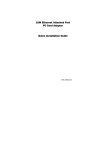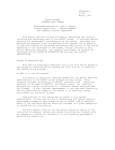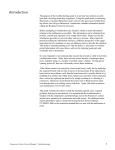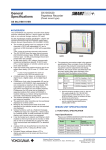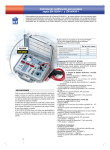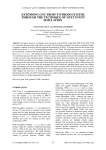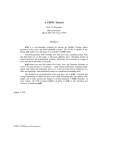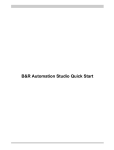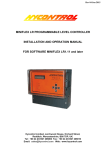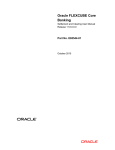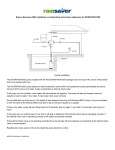Download ASSIST Assembler Replacement User`s Guide
Transcript
ASSIST Assembler Replacement User’s Guide Program&Documentation: John R. Mashey Pro ject Supervision : Graham Campbell PSU Computer Science Depart ment Preface This manual is the key reference source for the programmer who uses the replacement facility of ASSIST. This facility allows the programmer to write and test his own versions of certain program modules which are part of the ASSIST Assembler. The modules which are replaceable perform a wide variety of functions, thus allowing for a number of different course assignments covering important segments of a running 360 Assembler. Among those replaceable are modules for management of the symbol table, base register table, scanning and conversion of various constant types, and evaluation of both self- defining terms and general expressions. The entire replacement process can be performed with low o verhead, in-core, and batched, while allowing the user program no possible way to damage the rest of the ASSIST system. The first part of this manual briefly describes the internal structure of the ASSIST assembler, and lists the steps in the entire replacement process. Also included are the overall register and linkage conventions required of all replaceable modules. The second section describes the additional debugging facilities available to the writer of a replacement module. The third section shows the deck setup, Job Contro l Language, and PARM options needed to make a replacement run. The fourth section lists all messages which may be printed by the ASSIST Replace Monitor during a replacement run. The reader should be familiar with the following manual: ASSIST Introductory Assembler User’s Manual The above manual gives various information which may be required to write a program which can be run under ASSIST, and explains the various messages which may generated (other than Replace Monitor messages). Note also that this manual is structured similar to the above one. For replacement of certain of the modules, it may be necessary to examine the following manual for additional required information: ASSIST System Program Logic Manual 1 The ASSIST Replacement Process Overview of the ASSIST Assembler The ASSIST Assembler is a section of the entire ASSIST System which translates a deck of S/360 Assembler Language statements into object code, in memory. It is made up of approximately 30 control sections, of which 3 are main control programs. The overall control program is named MPCON0, which calls the main programs for each of the two passes in the assembler, and also calls all initialization and termination entry points for the various other modules in the assembler. During the first pass, under control of MOCON1, each card in the input source deck is read, scanned for label and opcode, and processed partially according to the type of opcode. Each statement is given a location counter value during this pass, and some types of statements are completely processed, such as EQU, START, ORG, etc. Each card image and its associated information is then saved into a large dynamic work area, until an END card is encountered. During the second pass, each statement saved in the dynamic area is retrieved and processed. Several different routines control the scanning of each statement and production of object code from it. Each statement's object code, if any, is loaded into memory, and the statement printed. Approximately half of the modules of the assembler can be replaced using the ASSIST Replace Monitor. In general, these modules are those which are fairly low-level routines, which are not required to have communication with many other modules, and which generally do not have to be able to examine variables and flags global to the entire assembler. They definitely are never required to modify storage outside the limits of t heir own storage. These characteristics make it possible for them to be replaced without requiring a great deal of knowledge of the internal workings of the ASSIST Assembler. 2 Steps in the Replacement Process 1. The programmer writes one control section which is to be assembled and used as a replacement for the existing one in ASSIST of the same name. This control section must have the following characteristics: a. b. The CSECT and ENTRY names (if any) must be defined and spelled exactly as the existing ones. Certain replaceable modules (such as EVALUT), are permitted to call existing ASSIST modules. Any module so called can be done so by listing the module name in an EXTRN statement, then referencing the module name by use of a V-type address constant. 2. After the user program is assembled and loaded into memory, the Replace Monitor searches its list of replaceable control sections for one defined as a csect in the user program. The required entry point names are found, if possible, in the user program. During this process, the Replace Monitor modifies certain address constants in the main control table of the assembler, which will permit it to regain control every time one of the replaced entry points is called. The messages labeled AR000, AR001, and AR002 may appear on the listing at this point. If it cannot find a legally replaceable csect name, the message AR100 is printed, and the replacement process terminated. The latter can also occur if the user program contains more serious erro rs than given by the value of the NERR parameter. 3. Various functions are performed to initialize the user program for later execution. These include initializing the user RFLAG to t he value given by the RFLAG= option in the PARM field (see PART III). Then, instead of executing the user program directly, the ASSIST Assembler is called to process a test deck, which follows the user program. 4. During the assembly of the test deck, any of the replace program's entry points may be called. Any such call is intercepted by the Replace Monitor. Using previously saved information, it supplies the parameter values to the original ASSIST entry point called, which returns the correct set of values to be computed by that entry. At this point, depending on certain bits in the current value of the user RFLAG, various debugging information may be printed. This may include the current card image being processed, the values of 5 parameter registers on entry to the Replace Monitor, and t heir correct values as returned by the original ASSIST module. These messages have labels AR051, AR052, AR054, respectively. 5. At this point, a check is made to assure that the entry point called actually was defined properly by the user. If not, the AR101 message is given, user storage is dumped, and the interception of calls is terminated. Otherwise, the user registers and counters are prepared, and the user program executed beginning at the address in his program given by the called entry point. The user program is not executed directly, but is interpreted to prevent it from 3 damaging any part of ASSIST. The user program may thus access storage outside its area, but may not modify such storage. 6. The user program is interpreted until it either terminates normally by returning to the return address supplied to it in R14, or terminates with some error. 7. If the user program terminated normally, the register values it returned are checked against the ones returned by the original module. In some cases, the exact register values do not matt er, but any value definitely wrong is noted. If anything is actually wrong, any debug information not already printed during step 4 is printed now. Then the values of the user-returned parameter registers are printed (AR058), followed by a message flagging the incorrect registers (AR059). The AR058 message may be printed in any case if the appro priate bit in the current value of the user RFLAG is turned o n. Another bit in the RFLAG is set if an error has occurred. This bit may be tested by the user program the next time it is called. The correct values are placed in the parameter registers, and control is returned t o the program which originally called the replaced entry point. 8. If the user program did not terminate normally, and the error was a branch out of the user program, it may be the case that the user program was attempting to call some other original ASSIST module. The call is checked to see if it is a legitimate one. If so, the parameter registers may be printed (AR050), and t hen checked to make sure they contain legal values. If they are illegal for any reason, they are flagged with message AR059, the user program is dumped, and no further calls are made to user entry points. If the call is legal, the desired routine is called, and its parameter values placed in the user's registers, and step 6 is begun once more. 9. Finally, the assembly of the test program is completed, with all calls having been made to the appropriate entry points of the user replacement program. Messages AR003 and AR004 are then printed, giving various statistics about the performance of the user program. These include the number of times each entry point was called, the total number of instructions executed by each entry, the number of times the values returned by the user program were incorrect, the average number of instructions executed per call, and the percent of the calls which were handled incorrectly. 10. If the option BATCH was specified, control returns to step 1, thus allowing different modules to be tested during one run. Otherwise, ASSIST execution terminates. 4 Register and Subroutine Linkage Conventions Register Usage The general purpose registers are referred to by two separate sets of symbols. The first is a set of absolute register equates, the symbols R0-R15 being used for registers 0-15. In addition, a second set exists which has more mnemonic meaning. The user is urged to utilize only symbolic registers in his program, and should thus include any of the required EQU instructions in his program. In particular, registers 7-11 should be coded using the symbols RA-RE. The additional symbolic register equates are as follows: RW RX RY RZ EQU EQU EQU EQU RA EQU R7 PARAMETER REGISTER 1 This register is commonly used as a scan pointer register inside the assembler. EQU R8 PARAMETER REGISTER 2 This register is commonly used to pass a control value to a subroutine, and on return, almost always contains either an error code, or a zero to show no errors. EQU R9 PARAMETER REGISTER 3 This register is most often used in the assembler for passing a 24-bit value (such as the result of an expression or a self-defining term). EQU R10 PARAMETER REGISTER 4 EQU R11 PARAMETER REGISTER 5 Registers RD and RE may be used for subroutines needing more than two or three arguments, but are more commonly used as work temporary work registers. RB RC RD RE RAT RSA RET REP R3 R4 R6 R6 GENERAL GENERAL GENERAL GENERAL WORK WORK WORK WORK REGISTER REGISTER REGISTER REGISTER 1 2 3 4 EQU R12 ASSEMBLER TABLE POINTER-READ ONLY This register points the main assembler table (VWXTABL csect, AVWXTABL dsect) during an assembly. No subroutine in the assembler may modify this register. EQU R13 SAVE AREA POINTER/BASE REG FOR SOME This register is used to point to an OS/360 save area, for any subroutine which may call another. Almost all subroutines use this as a base register if they are not lowest-level routines. EQU R14 RETURN ADDRESS USED IN CALLS This is used in subroutine linkage for the return address to a calling program. This symbol is generally used whenever subroutine linkage is being set up, while R14 is used when the register is being used as a temporary work register. EQU R15 ENTRY POINT ADDRESS/OFTEN USED BASE This register is used to hold the entry point address for all subroutines in the assembler. Lowest-level routines usually use this as a base register. In other routines, this may be used as a local work register, in which case the symbol R15 is normally coded. 5 Linkage Conventions - The Assembler The linkage conventions inside the ASSIST assembler consist of a few modifications to the standard OS/360 linkage conventions, which have been changed mainly to save time and space. The differences are as follows: 1. Registers R0-R6 (or R0-R2, RW-RZ) are protected across any calling sequence and must be restored if changed. R14 (RET) must also be restored if changed before returning. 2. Register R12 (RAT) may not be changed by any routine. 3. Registers R7-R11 (RA-RE) are used for parameters and temporary work registers, and are not protected at all across calls. No rout ine ever requires more than five arguments, so these five registers are sufficient. 4. Except for the above, all normal OS/360 conventions are followed regarding save area linkage requirements and usage. In general, most routine only save as many registers as required. Lowest-level routines use R15 as a base, and do not perform save area linkage, other routines usually use R13 as a base and save area pointer. 5. For replacement runs, the user must include any needed EQU symbols for registers. Note that all documentation and output produced by the Replace Monitor refers to registers 7-11 as RA-RE, so t hat using these symbols in a replacement program will aid reading the various diagnostic output produced. 6 Replace Monitor Debugging Aids The RFLAG Communication between the user program and the Replace Monitor is achieved through the use of the User Replace Flag, called the RFLAG. This is a two-byte area of storage which may initialized for an entire run using the RFLAG= option in the PARM field. Certain bits in it determine which diagnostic messages the Replace Monitor prints when it intercepts a call to a replaced module. These bits can also be changed by the user program during execution, thus allowing the user to obt ain additional information when needed. The various bits of the RFLAG are used as described in the table below. BYTE BITS DECIMAL BINARY MEANING IF BIT ON (AR### MESSAGE) -----------------------------------------------------------------------0 0-7 currently unused, user can set or test for his own purposes. 1 7 1 00000001 print current statement on entry (AR051) 6 2 00000010 print registers RA-RE on entry (AR052) 5 4 00000100 print correct regs RA-RE, on exit (AR054) from original ASSIST module 4 8 00001000 print registers RA-RE on exit from (AR058) user replacement module 3 16 00010000 print registers RA-RE if user (AR050) module calls an original ASSIST module. 1,2 64,32 01100000 reserved for future use 0 128 10000000 is set to 1 when there is an error (AR059) parameter registers returned by the user program. Is set to 0 if acceptable. ------------------------------------------------------------------------ Bit 0 of byte 1 can be used to start extra debugging out put o nly after an error occurs. See the XREPL example for this action. The entire first byte is reserved for the user program, such as for additional debugging flag bits for controlling the program. Note that bits 5,6,7 are tested before the call to the user program. Thus, changing them affects output beginning at the next call to a user module. The XREPL Instruction The XREPL instruction is an SI format instruction, in which the immediate field is used to specify a type of action. It is coded as XREPL addr,code with CODE meaning as follows: 0 1 2 set the RFLAG from the 2-byte area specified by ADDR. fetch the RFLAG into the 2-byte area specified by ADDR. fetch the number of instructions left into the 4-byte area given by ADDR. This value is decremented each time an instruction is done. 7 The following gives an example of the use of XREPL: XREPL TM BZ OI XREPL MYRFLAG,1 get the value of the RFLAG MYRFLAG+1,128 was there an error last time *+12 no, don't reset it MYRFLAG+1,8+4+2+1 set all these for debug output MYRFLAG,0 reset the RFLAG to new setting Job Control Language and PARM Options Job Control Language The deck setup for a single-job replacement run is as follows: // a JOB CARD // EXEC ASSIST,PARM='REPL,other options if any' //SYSIN DD * .....user-written replacement program..... END 1 end card of replacement program ..... user test deck for his replacement program..... /* // The deck setup for a replace program run under BATCH is: $JOB ASSIST ACCT#,REPL,other options, if any ..... user-written replacement program $ENTRY (required to initiate test) ..... user test deck for replacement program $ENTRY (optional, if user wants assembled test program to execute also - unlikely) PARM Options The following PARM field options are o f particular interest to the user of the replacement facility. (see PART III. of USER'S GUIDE). REPL required if the run is to be a replacement just a normal assembly and execution. run rather than RFLAG=number coded to initialize the value of the RFLAG for the entire run. The default value is 0. BATCH may be coded if the user wants to test more than one module, or more than one version of the same module in the same run. I=number the instruction count limit specified applies to each call of a replacement module. It is therefore recommended that this optional operand be coded, and that its value be fairly small. 8 Replace Monitor Messages The following lists the messages which may be produced during a replace run by the Replace Monitor. Note that all these messages are printed inline with output produced by other sections of ASSIST. In particular, Replace Monitor output is embedded in the listing of the user test program, which can possibly make it difficult to read in some cases. A helpful procedure is to run the test program by itself under ASSIST, thus obtaining a listing, then insert a PRINT OFF command at the beginning. This will remove most of he test program listing. All Replace Monitor messages are of the form ///AR### message. The type of message is indicated by the value of ###, as follows: 000-049 - informative or warning messages. 050-099 - debugging o utput messages,produced during intercepted call. 100-199 - severe error message, causing replacement interception to end. AR000 REPLACE CSECT: name /// This message appears immediately after the replace csect has been assembled, with name being the name of the replacing csect. AR001 REPLACE ENTRY: name AT LOCATION: xxxxxx /// If message AR000 appears, each properly defined entry point in the csect will be listed here with its location xxxxxx in memory. Note that a csect which can be entered through its csect name is also listed. AR002 REPLACE ENTRY: name NOT FOUND AS CSECT OR ENTRY /// This message may appear with the AR000 and AR001 messages for any entry or csect name which is required, but either not defined in the user program or not declared as CSECT or ENTRY. If this entry name is called during execution, its execution will be terminated with an AR101 message and storage dump. AR003 STATISTICS: # INSTRUCTIONS # CALLS # WRONG INSTRS/CALL %WRONG This message appears after the test program is assembled. AR004 name : 5 decimal numbers One of this message appears for each entry point after AR003. It describes the performance of the named entry point during the run. AR050 ON CALL TO name REGISTERS RA-RE (values of regs 7-11) This message may be printed if the RFLAG byte 1 bit 3 is set and t he user program calls some other ASSIST module. It may also be printed if the user program tries to pass illegal parameter values to the routine name. AR051 ON ENTRY TO name STMT ADDR: xxxxxx -> card image 9 This message is printed before calling the user program, and shows the current statement being processed, if any. The address of the card image is given by xxxxxx, which corresponds to the first character following the '>' in the message. The message is if RFLAG byte 1 bit 7 is set before the call, or if an error occurs in the user program. AR052 ON ENTRY TO name REGISTERS RA-RE: (values of 5 registers) This message displays the 5 parameter registers before the user program name is called, and is printed if RFLAG byte 1 bit 6 is on before the user program is called, o r if there is an error. AR054 ON EXIT FROM name REGISTERS RA-RE: (values of 5 registers) This message shows t he correct values of the parameter registers as returned by the original ASSIST module name. It is printed if RFLAG byte 1 bit 5 is on before call to the module, or if the user program makes an error. AR058 ON EXIT FROM name REGISTERS RA-RE: (values of 5 registers) If RFLAG byte 1 bit 4 is on after completion of the user program, or if there is an error, this message appears, and gives the values of the parameter registers as returned by the user entry name. AR059 WARNING: ERROR IN USER REGS: error list If any of the user registers has an incorrect value, this message is printed, either following AR050 or AR058, depending on whether the incorrect value(s) were in a call to another module or in a return of values to the calling program. The error list consists of one or more of the following: R0-R6 R12 R13 $$$$$$$$ when a user program returned, the values in registers 0-6 were not all the same as when it was called. the user program modified the value of the assembler table pointer, which is not permitted. the user did not restore the save area pointer. The dollar signs indicate a register shown in messages AR050 or AR058 as incorrect. If this message appears, RFLAG byte 1 bit 0 is set to 1 for the next time the user program is called. AR100 REPLACE CSECT NOT FOUND - REPLACE ABORT /// This message appears immediately after the assembly of the user program. None of the allowable csect names were found as a csect in the user program. AR101 INVALID ENTRYPOINT NAME: name CALLED. REPLACE ACTION ABORTED /// If name appeared in an AR002 message and is called, this message appears, followed by a dump of user storage and the last values of the user registers. AR102 USER PROGRAM ABENDED DURING REPLACEMENT /// Replace action is aborted and a dump given. 10










